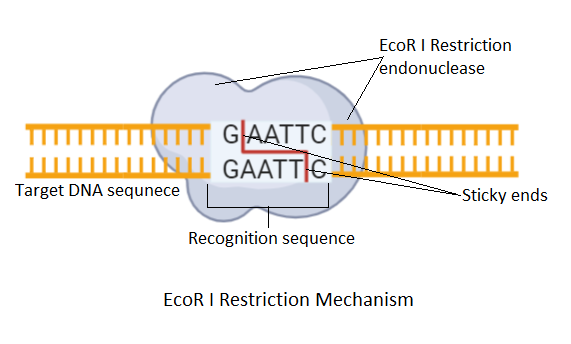
GAATTC is the restriction site, for which of the following restriction endonucleases?
A. HindIII
B. EcoRI
C. BamI
D. HaeIII
Answer
559.8k+ views
Hint: The restriction endonucleases are a special class of enzymes that are used to cut DNA. They are isolated from their respective bacterial strains and named after them. These enzymes recognize specific DNA sequences called recognition sequences. They have complementary base pairs that bind to the recognition sites.
Complete answer:
In recombinant DNA technology, the restriction enzymes play a major role by recognizing and cutting the specific genes of interest. The restriction enzymes are also called molecular scissors as they cut the double-stranded DNA molecule. These are of two types namely restriction endonucleases and restriction exonucleases. The endonucleases cut the DNA in between the sequence. On the other hand, the exonucleases cut the DNA from its ends. The restriction endonucleases are the ones that are used widely. The restriction endonucleases first recognize the target sequences in the DNA that needs to be cut by complementary base pairing. The specific sites that they recognize and to which they attach are called recognition sequences. Each restriction endonuclease has its unique recognition sequence. Now, EcoRI is a restriction endonuclease. It is a widely and commonly used restriction endonuclease. It was isolated from the bacteria called Escherichia coli. The Eco in its name stands for the bacterium name from which it was isolated. The R in the name represents the strain of the bacteria that is RY13 and I is the series in which it was isolated. The sequence of the EcoRI restriction endonuclease is CTTAAG. Thus, the complementary recognition sequence for it will be GAATTC. It produces sticky ends in the cut segment.

Hence, the right answer is option B.
Note: The restriction enzymes occur naturally in many bacterial species. They are the natural immune systems of the bacteria against the virus attacks. The bacteria use them to cut the foreign DNA sequences of the viruses. The restriction enzyme breaks down the viral genome and inactivates it protecting the bacterial cell from infection.
Complete answer:
In recombinant DNA technology, the restriction enzymes play a major role by recognizing and cutting the specific genes of interest. The restriction enzymes are also called molecular scissors as they cut the double-stranded DNA molecule. These are of two types namely restriction endonucleases and restriction exonucleases. The endonucleases cut the DNA in between the sequence. On the other hand, the exonucleases cut the DNA from its ends. The restriction endonucleases are the ones that are used widely. The restriction endonucleases first recognize the target sequences in the DNA that needs to be cut by complementary base pairing. The specific sites that they recognize and to which they attach are called recognition sequences. Each restriction endonuclease has its unique recognition sequence. Now, EcoRI is a restriction endonuclease. It is a widely and commonly used restriction endonuclease. It was isolated from the bacteria called Escherichia coli. The Eco in its name stands for the bacterium name from which it was isolated. The R in the name represents the strain of the bacteria that is RY13 and I is the series in which it was isolated. The sequence of the EcoRI restriction endonuclease is CTTAAG. Thus, the complementary recognition sequence for it will be GAATTC. It produces sticky ends in the cut segment.

Hence, the right answer is option B.
Note: The restriction enzymes occur naturally in many bacterial species. They are the natural immune systems of the bacteria against the virus attacks. The bacteria use them to cut the foreign DNA sequences of the viruses. The restriction enzyme breaks down the viral genome and inactivates it protecting the bacterial cell from infection.
Recently Updated Pages
Master Class 12 Business Studies: Engaging Questions & Answers for Success

Master Class 12 Economics: Engaging Questions & Answers for Success

Master Class 12 English: Engaging Questions & Answers for Success

Master Class 12 Maths: Engaging Questions & Answers for Success

Master Class 12 Social Science: Engaging Questions & Answers for Success

Master Class 12 Chemistry: Engaging Questions & Answers for Success

Trending doubts
What are the major means of transport Explain each class 12 social science CBSE

Which are the Top 10 Largest Countries of the World?

Draw a labelled sketch of the human eye class 12 physics CBSE

Explain sex determination in humans with line diag class 12 biology CBSE

The pH of the pancreatic juice is A 64 B 86 C 120 D class 12 biology CBSE

Explain sex determination in humans with the help of class 12 biology CBSE




